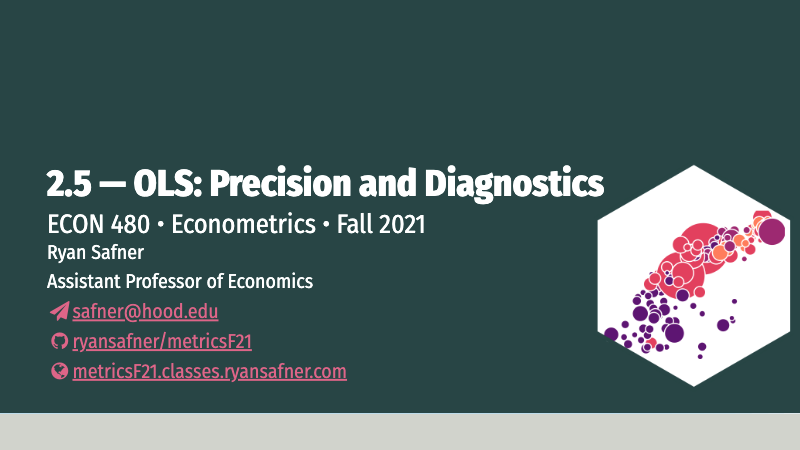Thursday, September 23, 2021 and Tuesday, September 28, 2021 (for R Practice)
Note: there is a video posted on Blackboard for the Thursday September 23 lecture.
Overview
Last class and this class we are looking at the sampling distibution of OLS estimators (particularly \(\hat{\beta_1})\). Last class we looked at what the center of the distribution was - the true \(\beta_1\) - so long as the assumptions about \(u\) hold:
- When \(cor(X,u)=0\), \(X\) is exogenous and the OLS estimators are unbiased.
- What \(cor(X,u)\neq 0\), \(X\) is endogenous and the OLS estimators are biased.
Today we continue looking at the sampling distibution by determining the variation in \(\hat{beta_1}\) (it’s variance or its standard error1). We look at the formula and see the three major determinants of variation in \(\hat{\beta_1}\):
- Goodness of fit of the regression \((SER\) or \(\hat{\sigma_u}\)
- Sample size \(n\)
- Variation in \(X\)
We also look at the diagnostics of a regression by looking at its residuals \((\hat{u_i})\) for anomalies. We focus on the problem of heteroskedasticity (where the variation in \(\hat{u_i])\) changes over the range of \(X\), which violates assumption 2 (errors are homoskedastic): how to detect it, test it, and fix it with some packages. We also look at outliers, which can bias the regression. Finally, we also look at how to present regression results.
We continue the extended example about class sizes and test scores, which comes from a (Stata) dataset from an old textbook that I used to use, Stock and Watson, 2007. Download and follow along with the data from today’s example:2
I have also made a RStudio Cloud project documenting all of the things we have been doing with this data that may help you when you start working with regressions:
Readings
- Finish Ch.3 in Bailey, Real Econometrics
Slides
Below, you can find the slides in two formats. Clicking the image will bring you to the html version of the slides in a new tab. Note while in going through the slides, you can type h to see a special list of viewing options, and type o for an outline view of all the slides.
The lower button will allow you to download a PDF version of the slides. I suggest printing the slides beforehand and using them to take additional notes in class (not everything is in the slides)!
R Practice
Today you will be working on R practice problems on regression. Answers will be posted later on that page.
Assignments
Problem Set 2 Answers
Problem Set 2 answers are posted on that page.
New Packages Mentioned
broom: for tidy regression outputs, summary statistics, and adding \(\hat{Y_i}\) and \(\hat{u_i}\) into the dataframehuxtable: to present regression output in a table withhuxreg()lmtest: for testing for heteroskedasticity in errors withbptest()car: for testing for outliers withoutlierTest()estimatr: for calculating robust standard errors withlm_robust()
Appendix
Robust Standard Errors in R
This, since I started using huxtable instead of another package (stargazer) to make regression tables, I have gone all in on estimatr’s lm_robust() option to calculate robust standard errors. Before this, there were some other methods that I had to resort to. You can read about that in this blog post.
